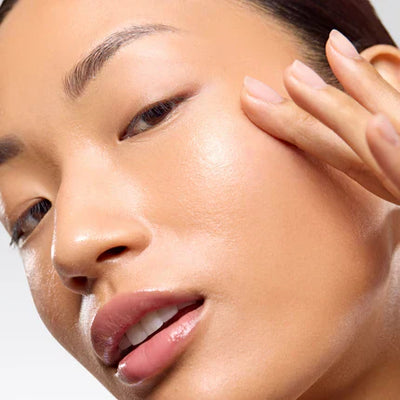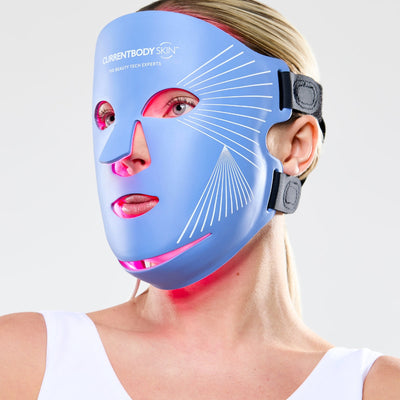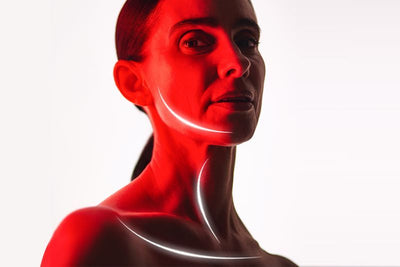If you thought acne was something you’d outgrow after your teenage years, you’re not alone. Blemish-prone skin is a fact of life for most of us at one point or another and can have a huge impact on self-esteem.
While you’ll find an abundance of blemish relief balms, creams and everything in between on the shop shelves, if you’re seeing spots pop up later in life you might be looking for something a little more effective for banishing unwelcome blemishes.
Enter blue light therapy. That's right, the skincare solution you’ve been craving might not be another cream or cleanser, but an LED blue light therapy mask. Before we dive into how blue light therapy is used to target acne-causing bacteria, to help treat adult acne. Let’s take a closer look at what it is and actually causes adult acne in the first place.
What is Adult Acne?
Adult acne is simply acne that appears after the age of 25. And it’s more common than you think. In fact, a study by Pierre Fabre Laboratories, found that 1 in 5 people worldwide are affected.
While anyone can develop adult acne, women are more prone than men, often thanks to hormonal changes, stress, and everyday life getting in the way of skin balance.
Now that we know what it is, the real question is: why do I have adult acne? Let’s find out.
What causes Adult Acne?
Acne develops when pores become blocked with excess sebum (oil produced naturally by the skin to keep it hydrated). Once clogged, the blemish-causing bacteria Cutibacterium acnes breeds, leading to inflammation and, you guessed it, blemishes.
More specifically adult acne can be caused by the following:
Hormonal changes
Affecting sebum production, hormonal fluctuations are the main cause of adult acne, whether due to the menstrual cycle, pregnancy or menopause. An increase in androgens, hormones like testosterone, can also boost oil production and trigger breakouts, explaining why so many people experience acne throughout adulthood, even if avoided during adolescence.
Stress
Have you ever noticed how spots seem to appear right before an important or stressful event? That's no coincidence. Stress raises cortisol levels which tells your oil glands to produce more sebum. More oil equals more clogged pores and more breakouts.
Skincare and cosmetics
While you may think that investing in expensive skincare is the answer to achieving clear and glowing skin, this isn’t always the case. Ironically, sometimes the products we apply in good faith can be to blame. Heavy foundations, pore-clogging moisturisers, or over-exfoliating scrubs can all irritate the skin and trap oil and bacteria.
Lifestyle factors
Your daily habits play a bigger role in your skin health than you might think. Diets high in sugar or dairy have been linked to acne flare-ups, while smoking reduces oxygen to the skin and slows healing. Throw in lack of sleep (your body’s natural repair time) and you’ve got a recipe for stubborn breakouts.
Medical conditions and medications
Sometimes, adult acne isn’t about lifestyle at all. It can be linked to underlying health issues or the medications you are taking, Hormonal disorders like PCOS are well-known acne triggers, and certain drugs (including steroids, lithium, or some birth control methods) can make acne worse.
If you suspect this is the case, it’s recommended to talk with your doctor or a dermatologist for advice.

Why is adult acne different from teenage acne?
While teenage acne is primarily caused by hormonal changes during puberty, adult acne is more likely to be linked to stress. The location of blemishes is also expected to differ – think your classic t-zone for teens, while adults tend to see more spots on the lower half of the face, across the jawline and chin.
Types of adult acne and how to identify them
There are different types of adult acne, ranging in severity relating to the depth of tissue affected and the level of inflammation caused.
Non-Inflammatory Acne:
This type of acne is caused by clogged pores without significant swelling of redness:
-
Blackheads appear as small black or yellowish bumps on the skin and are open pores clogged with oil.
-
Whiteheads are closed pores clogged with oil and dead skin and appear as small firm white or skin-coloured bumps.
Inflammatory Acne:
This type of acne is also caused by clogged pores but they become red, swollen and sometimes painful:
-
Papules appear as small, red, tender bumps with no visible pus.
-
Pustules are similar to papules but contain visible pus at the tip.
-
Nodules are large, hard, painful lumps deep under the skin with no visible head.
-
Cysts are large, soft, pus-filled lumps under the skin and can scar.
How to treat adult acne with blue light therapy?
Blue light therapy is a non-invasive, drug-free way to target one of acne’s main causes: Cutibacterium acnes (C. acnes) bacteria. This specific wavelength (415nm) of light penetrates the skin’s surface and destroys acne-causing bacteria without harming healthy cells.
"Blue light penetrates the upper layers of the skin and helps destroy acne-causing bacteria while calming inflammation. While blue light therapy is most commonly used to target acne-causing bacteria (C. acnes) on the skin, It’s particularly helpful for red, inflamed spots. Some studies also suggest it can help regulate oil production and reduce the appearance of pores over time. "
- Dr Pyal, Dermatologist, The Beauty Tech Group Medical Board
So, if targeting acne causing bacteria isn’t enough, blue light also helps control oil production by shrinking the sebaceous glands responsible for producing oil while promoting skin regeneration and reducing inflammation.
By reducing oil production (and therefore the chances of pores becoming clogged), killing blemish-causing bacteria, and reducing inflammation, blue light therapy is an effective non-invasive measure for treating and preventing adult acne while avoiding medication and any side effects of treatment.
Did you know that the CurrentBody Skin LED Blue Light Therapy Face Mask Series 2 not only uses the exact blue light wavelength associated with the best results (415nm) but red light (633nm)? Proven to reduce inflammation and calm redness while promoting healing and fading scarring.

Why people love blue light therapy for adult acne
As mentioned, blue light therapy works beneath the surface to tackle the real cause of breakouts, while being gentle enough to slot right into your routine. Here’s why so many people swear by it:
-
Targets acne-causing bacteria at the source
-
Helps calm redness and swelling
-
Supports skin healing without stripping moisture
-
Can be combined with your usual skincare routine
Interested in learning more with insights from a dermatologist? Read our blog on the benefits of blue light therapy.
Blue light therapy and other adult acne products
Blue light therapy can easily fit into your daily skin care routine. However, if you are using any other adult acne products, you should check with your doctor or a skin care professional before including blue light therapy into your skin care routine.
Using blue light therapy masks at home for adult acne
When using a LED blue light therapy mask like the one from CurrentBody Skin, you’ll experience 10-minute light therapy sessions to banish blemishes quickly and effectively, so you can sit back and relax for a moment of skin-boosting self-care from the comfort of your home.
It’s recommended to use the device 3-5 times a week for 6 weeks to see the best results. And after 6 weeks of use, it’s best to give your skin a short rest period of 1-2 weeks before resuming your treatment.
Having said this, it's important to note that if you only have one or two blemishes, it’s best to avoid using blue light therapy excessively, as overuse can potentially lead to skin sensitivity, dryness or pigmentation issues.
Always follow your device’s instructions and consult a skincare professional before beginning any new skin care regimen.
Who will see the best results?
Blue light therapy works wonders for mild to moderate inflammatory acne. If your breakouts are severe, cystic, or linked to an underlying condition, your doctor or a dermatologist can guide you on combining blue light with other treatments.

Dealing with post-acne scarring
Unfortunately, adult acne tends to scar more than teenage spots. This is because adult acne is more likely to be cystic and cause damage to deeper layers of skin, unlike teenage acne, which tends to be more superficial (think blackheads and whiteheads).
Thankfully, the red light wavelength emitted by the CurrentBody Skin Anti-Blemish Light Therapy Face Mask Series 2 helps to prevent and heal scarring by boosting collagen production (crucial for skin plumpness and volume), promoting cell repair and improving blood circulation, all helping to heal and fade scarring.
So, soothe your spots and banish blemishes with your new complexion-clearing must-have, and never forget the cardinal rule – whatever you do, don’t pick.





